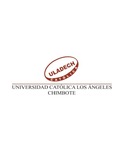| dc.contributor.author | Hernández-Vásquez, A. | |
| dc.contributor.author | Azañedo, D. | |
| dc.contributor.author | Antiporta, D.A. | |
| dc.contributor.author | Cortés, S. | |
| dc.date.accessioned | 2019-01-23T00:23:56Z | |
| dc.date.available | 2019-01-23T00:23:56Z | |
| dc.date.issued | 2017-01 | |
| dc.identifier.citation | Hernandez-Vasquez A, Azanedo D, Antiporta DA, Cortes S. [Spatial analysis of gestational anemia in Peru, 2015]. Revista peruana de medicina experimental y salud publica. 2017;34(1):43-51 | es_ES |
| dc.identifier.issn | 17264634 | |
| dc.identifier.uri | http://repositorio.uladech.edu.pe/handle/123456789/8665 | |
| dc.description.abstract | Objectives. To establish regional prevalences of anemia in pregnant women receiving care at public clinics in Peru in 2015 and identify high-prevalence district conglomerates. Materials and Methods. An ecological study was carried out on data from pregnant women with anemia registered on the Nutritional Status Information System (SIEN) who received care in 7703 public clinics in 2015. Regional and district prevalences of gestational anemia were calculated. District conglomerates with a high prevalence of gestational anemia were identified using the Moran Index. Results. Information was gathered from 311,521 pregnant women distributed in 1638 districts in Peru. The national prevalence of anemia was 24.2% (95% confidence interval [95% CI]: 24.0-24.3%), the rural prevalence was 30.5%, and the urban prevalence was 22.0%. The regions of Huancavelica (45.5%; 95% CI: 44.2-46.7%), Puno (42.8%; 95% CI: 41.9-43.7%), Pasco (38.5%; 95% CI: 36.9-40.0%), Cusco (36.0%; 95% CI: 35.3-36.8%), and Apurímac (32.0%; 95% CI: 30.8-33.1%) had the highest prevalences of anemia. The local Moran Index identified 202 high-priority districts (hot spots) (12.3% of total; 44 urban and 158 rural) located in Ancash, Apurímac, Arequipa, Ayacucho, Cajamarca, Cusco, Huancavelica, Huánuco, Junín, La Libertad, Lima, Pasco, and Puno containing high-prevalence district conglomerates. Conclusions. Gestational anemia in Peru has its highest prevalence rates in rural and southern mountainous areas. The district conglomerates with high prevalence rates of gestational anemia coincide with the areas of high regional prevalence. © 2017, Instituto Nacional de Salud. All rights reserved. | es_ES |
| dc.format | application/pdf | es_ES |
| dc.language.iso | spa | es_ES |
| dc.publisher | Universidad Católica los Ángeles de Chimbote | es_ES |
| dc.relation.isPartOf | Revista Peruana de Medicina Experimental y Salud Publica | es_ES |
| dc.rights | info:eu-repo/semantics/openAccess | es_ES |
| dc.source | Universidad de Buenos Aires, Buenos Aires, Argentina | es_ES |
| dc.source | Instituto de Investigación, Universidad Católica los Ángeles de Chimbote, Chimbote, Peru | es_ES |
| dc.source | Johns Hopkins Bloomberg School of Public Health, Baltimore, United States | es_ES |
| dc.subject | Anemia; Iron; iron supplements | es_ES |
| dc.title | Spatial analysis of gestational anemia in Peru, 2015 [Análisis espacial de la anemia gestacional en el Perú, 2015] | es_ES |
| dc.type | info:eu-repo/semantics/article | es_ES |
| dc.identifier.journal | Elsevier | es_ES |

